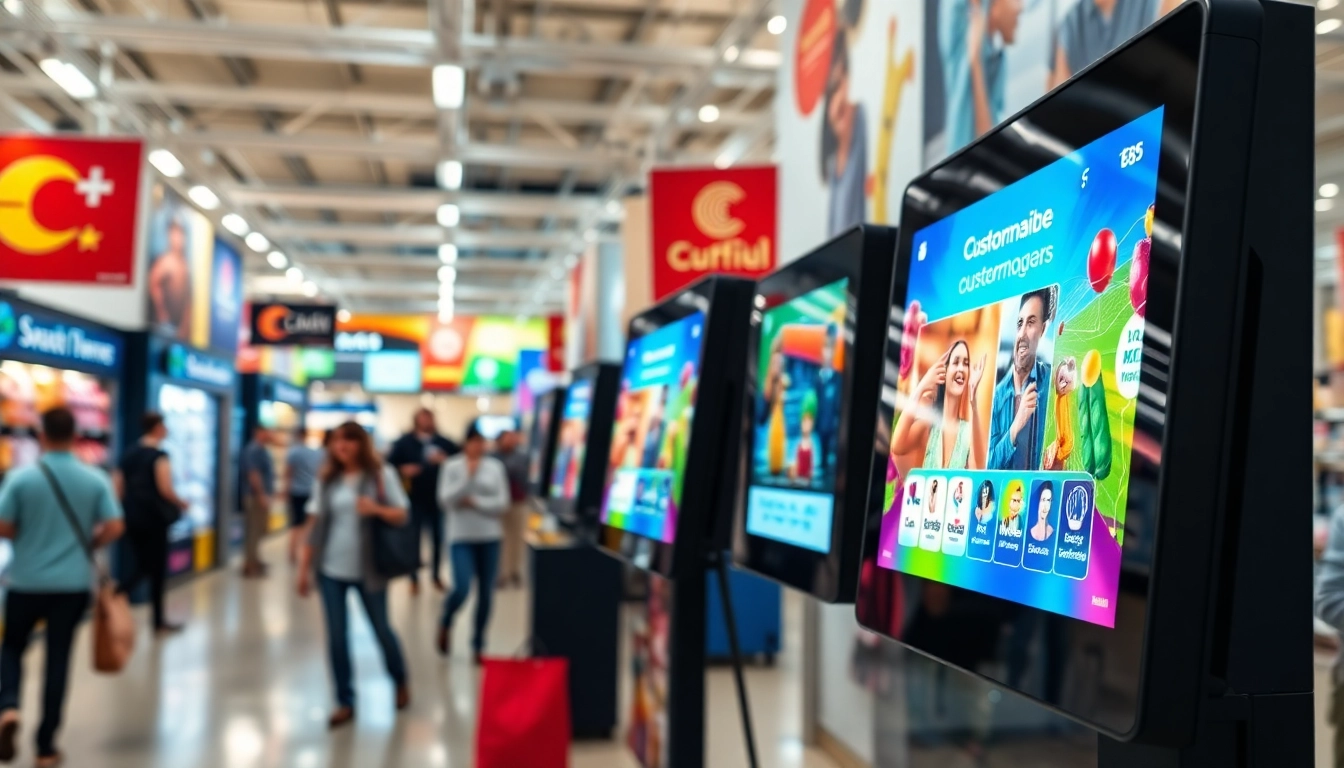Understanding Digital signage: Definition and Benefits
What is Digital signage?
Digital signage is an advanced form of electronic signage that utilizes various digital display technologies, such as LED screens, LCDs, and projection, to present dynamic multimedia content. This content can include text, images, video, and interactive elements, all aimed at delivering information to audiences in public and private spaces. As businesses continue to adopt this technology, the innovative possibilities for communication and marketing strategies are becoming increasingly apparent. Digital signage transforms the way brands communicate with customers, allowing for real-time updates and engaging presentations that can be tailored to specific audience segments.
Key advantages of Digital signage for businesses
Implementing digital signage provides numerous benefits for businesses, amplifying their messaging and enhancing customer engagement. Here are some of the most notable advantages:
- Enhanced Engagement: The vibrant visuals and moving content of digital signs capture attention more effectively than static signage, increasing viewer engagement.
- Real-time Content Updates: With digital signage, businesses can swiftly update information, ensuring that content remains current and relevant without the need for costly print runs.
- Cost Efficiency: Although initial setup costs can be significant, the long-term savings from reduced printing and maintenance expenses can outweigh these early investments.
- Targeted Messaging: Businesses can tailor content for specific demographics or locations, ensuring that messaging resonates with the intended audience.
- Data Integration: Digital signage can integrate with various data sources, such as social media feeds, to display real-time information and respond to current events.
Comparative landscape: Digital signage vs. traditional signage
When comparing digital signage to traditional signage, distinct differences emerge that can influence a business’s decision to adopt modern technology:
| Feature | Digital Signage | Traditional Signage |
|---|---|---|
| Content Flexibility | Highly flexible; update content frequently. | Static; content requires physical replacement. |
| Visual Appeal | Dynamic; incorporates videos and animations. | Static; limited to printed graphics. |
| Cost Effectiveness | Long-term cost-effective with lower operational costs. | Initial lower costs, but higher lifetime costs. |
| Engagement | High due to interactivity and motion. | Lower; often overlooked by consumers. |
Implementing Digital signage: Steps to Success
Deciding on the right Digital signage platform
The success of digital signage implementation hinges on selecting the right platform. Several factors should be evaluated when making this choice:
- User-friendliness: The interface should be intuitive, enabling users to create and manage content without extensive training.
- Features and Customizability: Look for platforms that offer a range of functionalities, including templates, scheduling, and analytics.
- Support and Resources: Ensure the platform has robust customer support and access to tutorials or resources for straightforward troubleshooting and learning.
- Cost: Budget constraints should be considered, including upfront and ongoing costs related to subscriptions and hardware.
Design essentials for effective Digital signage content
Effective digital signage content requires thoughtful design. Here are some essential elements to consider:
- Clarity: Ensure that messages are straightforward and easily comprehensible at a glance.
- Visual hierarchy: Use size, color, and contrast to guide viewers’ attention to key focal points.
- Brand alignment: Content should reflect the company’s branding guidelines to promote consistency across platforms.
- Call to Action: Clearly define what action you want the viewer to take, whether it’s visiting a website or making a purchase.
Hardware and software considerations for Digital signage
Investing in appropriate hardware and software is crucial for seamless digital signage operation. Key considerations include:
- Display Technology: Choose from LED, LCD, or projection based on space, viewing distance, and content type.
- Playback Devices: Select media players that are compatible with your signage software and provide the necessary processing power.
- Network Infrastructure: Ensure robust connectivity, whether wireless or wired, to facilitate remote updates and management.
- Content Management System (CMS): A powerful CMS is vital for efficiently organizing and scheduling content across multiple displays.
Measuring Success: Metrics and Analysis
Key performance indicators for Digital signage effectiveness
To assess the effectiveness of digital signage, businesses should monitor various key performance indicators (KPIs), including:
- Audience Reach: Track how many individuals view your signage and the frequency of views.
- Engagement Rates: Measure interactions with content, such as responses to calls to action or touchscreen engagement.
- Content Performance: Analyze which pieces of content are most effective in achieving business goals.
- Sales Impact: Correlate signage presence with sales figures to gauge its influence on customer purchases.
Analyzing audience engagement with Digital signage
Understanding how audiences interact with digital signage is vital for refining content strategy. Consider the following methods of audience engagement analysis:
- Surveys and Feedback: Conduct surveys to gather direct feedback from viewers about their perception of the digital signage content.
- Eye-tracking Technology: Invest in technology that tracks viewer eye movements to identify which areas of the signage capture the most attention.
- Heat Maps: Use software to visualize viewer interactions over time, helping identify effective content placements.
Tools and strategies to assess Digital signage performance
Employ various tools and strategies to enhance performance assessment:
- Analytics Software: Utilize analytics tools to capture data about viewer interactions and compile reports.
- Real-time Monitoring: Implement systems that provide live updates on content performance, enabling users to make quick decisions.
- A/B Testing: Experiment with different content types, layouts, and messaging to see which options yield the best results.
Common Challenges in Digital signage Implementation
Addressing content management difficulties
Content management is a crucial aspect of digital signage that can present challenges for businesses. Consider the following strategies to overcome these difficulties:
- Centralized Systems: Use a centralized content management system to streamline content creation, scheduling, and distribution across multiple displays.
- Collaboration Tools: Encourage collaboration among teams through shared platforms for content development and feedback loops.
- Regular Audits: Conduct audits of current content to ensure it remains relevant, fresh, and engaging for the audience.
Overcoming technical issues with Digital signage setups
Technical issues can hinder a successful digital signage initiative. To mitigate these problems:
- Robust Network Infrastructure: Invest in reliable networking solutions to minimize disruptions in connectivity during content updates.
- Regular Maintenance: Schedule routine checks on hardware and software systems to detect and resolve issues proactively.
- Training Staff: Provide comprehensive training for team members on troubleshooting common technical problems.
Managing costs effectively for Digital signage
Cost management is a fundamental consideration for businesses implementing digital signage. Here are strategies to keep expenses in check:
- Budget Planning: Establish a clear budget before commencement, encompassing all anticipated costs, from hardware to content development.
- Evaluate ROI: Regularly assess the return on investment to determine the financial efficacy of the digital signage initiative.
- Long-term Contracts: Negotiate long-term agreements for software licensing to secure lower rates and predictable expenses.
Future Trends in Digital signage Technology
Integration of AI and analytics in Digital signage
As technology evolves, the incorporation of artificial intelligence into digital signage will enhance the personalization and efficiency of content delivery. AI will enable:
- Dynamic Content Adjustment: AI algorithms can adapt signage content in real-time based on audience demographics and behavior.
- Predictive Analytics: Businesses can leverage data to forecast trends and optimize content strategies for maximum engagement.
Personalization trends in Digital signage experiences
Tailoring content according to individual preferences is a significant trend in digital signage. Consider the advantages of personalized signage:
- Increased Relevance: Deliver personalized messages based on customer interests and history, enhancing engagement rates.
- Enhanced Customer Experience: Offering targeted promotions or information can significantly improve the customer journey.
Impact of mobile and interactive solutions on Digital signage
The rise of mobile technology offers opportunities for more interactive digital signage experiences. Engaging consumers through their smartphones can include:
- QR Codes: Using QR codes on digital displays allows viewers to access additional information or promotions instantly.
- Interactive Touchscreens: These technology pieces enable users to engage directly with content, making the experience more immersive.


